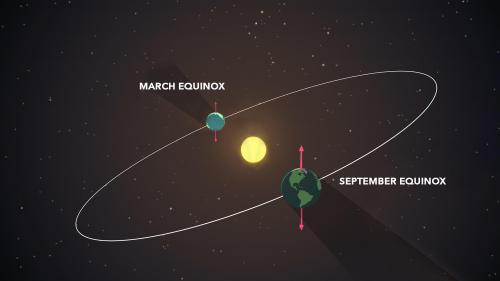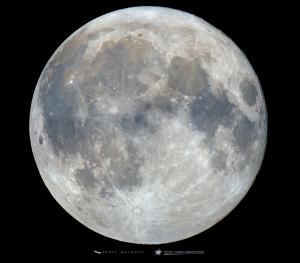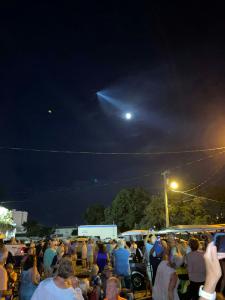Celebration of Space - September 17, 2021
This coming Wednesday, September 22, 2021 at 3:21 pm EDT, Earth will reach the point in our orbit where we are neither tilted towards or away from the Sun. This is the Autumnal Equinox and marks the first day of autumn in the Northern Hemisphere. Those who live along Earth’s equator will see the Sun rise due East, pass directly overhead (zenith) at noon, and set due West. Allowing for nearly equal duration of day and night times worldwide. Since we are neither tilted towards nor away from the Sun, sunrise and sunset times will be the same for corresponding locations in the Northern and Southern hemispheres. The Autumnal Equinox also signals a shift in day and night duration to the part of the year with longer nights in the Northern Hemisphere. All that aside, this event calls in the first day of autumn in the Northern Hemisphere and with it comes beautiful autumn colors, pumpkin pie, autumn festivals like Oktoberfest, spooky décor, maniacal leaf-peeping, lunar halos, the Andromeda Galaxy, and the inevitable dive into super short days with cooler temps – a stargazers playground. So step out this Wednesday and welcome the start of the autumn season and all the amazing trappings that come with it.
This coming Monday, September 20, 2021 at 7:55 pm ET, the September full Moon will occur. The September Moon is named the Full Corn Moon, for obvious reasons to anybody who lives in rural areas. But this year, and usually, the September Moon will carry another name and double up as the Harvest Moon. The Harvest Moon doesn’t always happen in September, and occasionally the October Moon will carry the Harvest Moon moniker. The Harvest Moon is defined as the closest full Moon to the Autumnal Equinox. Being that the full Moon and the Equinox are less than two days apart this year, September clearly has the Harvest Moon. There is a lot of buzz around the Harvest Moon, some of it is true, others not so much. We often hear that the Harvest Moon is the brightest and biggest full Moon of the year, so bright that farmers can harvest crops by its light. That statement is not entirely true. Essentially, one could harvest crops by the light of any full Moon, with the December full Moon probably being the best for that purpose, due to it being so high in the sky. The reason the Harvest Moon gets that buzz is because it happens during the harvest, which isn’t happening in December. As for the Harvest Moon being big and bright, the view will not be any bigger or brighter than any other full Moon, aside from perigee vs apogee (close and far distance in orbit), which is usually a minor difference that goes largely unnoticed. This year’s Harvest Moon is happening closer to lunar apogee, which will occur on September 26th, which will make this year’s Harvest Moon a bit smaller and dimmer. There are also local environmental effects as well, like wildfire smoke dimming the Moon and making it look redder. Regardless, the Harvest Moon is another awesome indicator that the hot days of summer are coming to an end in the Northern Hemisphere, and the festive fall season is underway. So step outside a few hours after sunset on Monday and say farewell to summer with a view of the beautiful Harvest Moon.
On Wednesday, September 15, 2021 the Inspiration4 mission launched from NASA’s Kennedy Space Center on SpaceX hardware, carrying the first all-civilian crew. The mission will orbit Earth for about 3 days before returning. The Crew Dragon, which is the orbital vehicle, will be passing over the United States tonight, and will be visible twice over our region, if clouds permit a view. Here are pass times for tonight:
Starting at 8:09 pm in the WSW, rising to 75°, heading towards the NE, and into orbital sunset
Starting at 9:50 pm in the WNW, rising to 23° and into orbital sunset
If that is not inspirational enough, there are evening passes of the International Space Station (ISS) also happening tonight, and every night this weekend and coming week. Here is a list of notable evening passes visible over our region:
Fri, Sep 17 at 8:15 pm, starting in the WSW, rising to 74°, heading towards the NE and into orbital sunset ← Awesome pass!
Sat, Sep 18 at 7:28 pm, starting in the SW, rising to 67°, heading towards the ENE ← Awesome pass!
Sun, Sep 19 at 8:18pm, starting in the W, rising to 31°, heading towards the NNE and into orbital sunset
Mon, Sep 20 at 7:31 pm, starting in the WSW, rising to 44°, heading towards the NE
Tue, Sep 21 at 8:22 pm, starting in the WNW, rising to 19°, heading towards the NNE and into orbital sunset
Wed, Sep 22 at 7:35 pm, starting in the WNW, rising to 23°, heading towards the NE.
Thu, Sep 23 at 8:26 pm, starting in th WNW, rising to 15°, heading towards the NNE and into orbital sunset
These times are applicable to Southern New England, and are generally acceptable for the Northeast. For daily pass times of the ISS and other notable satellites, visit the Frosty Drew Daily Satellite Prediction utility.
Have a happy Autumnal Equinox from all the astro-geeks at Frosty Drew Observatory and Science Center!
- Author:
- Scott MacNeill
- Entry Date:
- Sep 17, 2021
- Published Under:
- Scott MacNeill's Columns




